
The Salicaceae are the willow family of flowering plants. The traditional family included the willows, poplars. Genetic studies summarized by the Angiosperm Phylogeny Group (APG) have greatly expanded the circumscription of the family to contain 56 genera and about 1220 species, including the tropical Scyphostegiaceae and many of the former Flacourtiaceae.

Xylosma is a genus of flowering plants in the family Salicaceae. It contains around 100 species of evergreen shrubs and trees commonly known as brushhollies, xylosmas, or, more ambiguously, "logwoods". The generic name is derived from the Greek words ξύλον (xylon), meaning "wood, tree", and ὀσμή (osmé), meaning "smell", referring to the fragrant wood of some of the species. The Takhtajan system places it in the family Flacourtiaceae, which is considered defunct by the Angiosperm Phylogeny Group.
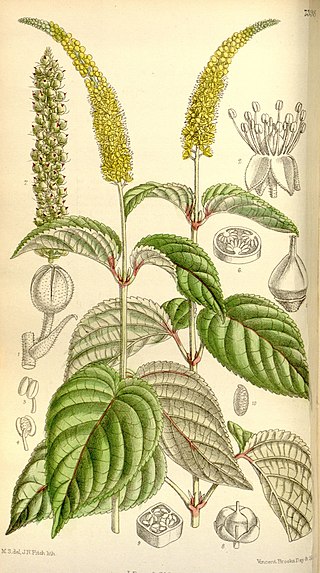
Abatia is a genus of about ten species of Central and South American trees in the family Salicaceae. Previously, it was treated in the family Flacourtiaceae, or tribe Abatieae of the family Passifloraceae or Samydaceae by G. Bentham & J.D. Hooker and Hutchinson.

Richard Spruce was an English botanist specializing in bryology. One of the great Victorian botanical explorers, Spruce spent 15 years exploring the Amazon from the Andes to its mouth, and was one of the very first Europeans to observe many of the places where he collected specimens. Spruce discovered and named a number of new plant species, and corresponded with some of the leading botanists of the nineteenth century.

Banara is a genus of flowering plants in the family Salicaceae.

Euplassa is a genus of flowering plants in the protea family. It is native to tropical South America, including Bolivia, Brazil, Colombia, Ecuador, French Guiana, Guyana, Peru, Suriname, and Venezuela.
Lasiochlamys is a genus of flowering plants endemic to New Caledonia in the family Salicaceae. Molecular phylogenetic analysis suggest that Lasiochlamys may be nested in the more widespread genus Xylosma.

Pineda is a genus of flowering plants in the family Salicaceae. It contains two species of shrubs: Pineda incana, which is native to the Andes of Ecuador and Peru, and Pineda ovata, which is native to the Andes of Bolivia.
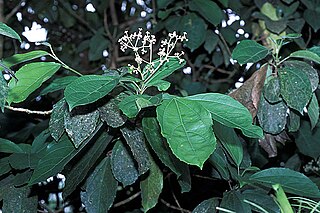
Hasseltia is a genus of flowering plants in the family Salicaceae. It contains four species of small to medium-sized trees native to the neotropics, ranging from Mexico south to Brazil and Bolivia. The genus is named for the Dutch physician and botanist Johan Conrad van Hasselt.
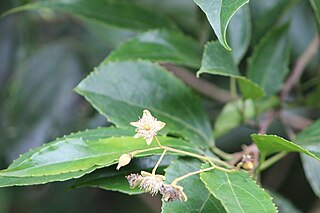
Macrohasseltia is a monotypic genus of flowering plants in the family Salicaceae. It consists of one species of tree: Macrohasseltia macroterantha, which is native to Central America. Formerly placed in the heterogeneous family Flacourtiaceae, Macrohasseltia is now classified in Salicaceae, along with close relatives Bennettiodendron, Carrierea, Idesia, Itoa, Olmediella, Poliothyrsis, and even the willows (Salix) and cottonwoods (Populus) themselves.

Olmediella is a monotypic genus of flowering plants in the family Salicaceae. It consists of one species of trees: Olmediella betschleriana, which is native to Central America. Formerly placed in the heterogeneous family Flacourtiaceae, Olmediella is now classified in Salicaceae, along with close relatives Bennettiodendron, Carrierea, Idesia, Itoa, Macrohasseltia, Poliothyrsis, and even the willows (Salix) and cottonwoods (Populus) themselves.
Hasseltiopsis is a monotypic genus of flowering plants in the family Salicaceae. It consists of one species of trees: Hasseltiopsis dioica, which is native to Central America. Formerly placed in the heterogeneous family Flacourtiaceae, Hasseltiopsis is now classified in Salicaceae, along with close relatives Prockia, Pineda, Neosprucea, and Banara.
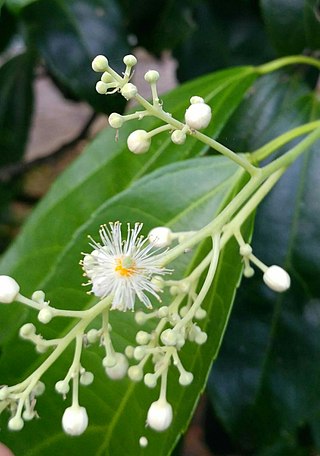
Pleuranthodendron is a genus of flowering plants in the family Salicaceae. It consists of one species of small to medium-sized trees native to the neotropics, specifically Central America and northern South America.
Ahernia is a genus of a single species, Ahernia glandulosa, a tree in the family Achariaceae, native to Hainan and Luzon island of the Philippines. Previously it was treated in the family Flacourtiaceae before being placed in Achariaceae. Ahernia is closely related to the American genera Hasseltia, Macrothumia, and Pleuranthodendron, but differs in its axillary racemes and more numerous (10–15) petals. Ahernia glandulosa is found in low elevation primary forests and is known in the Tagalog language as butun or sanglai. It grows 8–15 m (26–49 ft) tall.
Euceraea is a genus of flowering plants in the family Salicaceae. The genus is native to north South America throughout the North Region of Brazil, Colombia, Guyana, Suriname, and Venezuela.
Irenodendron is a genus of flowering plants in the family Salicaceae native to northern South America.

Macrothumia is a genus in the willow family Salicaceae with a single species Macrothumia kuhlmannii. It is a tree native to the states of Bahia, Espírito Santo, and Minas Gerais in Brazil. Formerly classified in the genus Banara in the family Flacourtiaceae, phylogenetic analyses based on DNA data indicate that this species, along with its close relatives in Ahernia, Hasseltia, and Pleuranthodendron are better placed in a broadly circumscribed Salicaceae. Macrothumia differs from its close relatives in having a congested fascicle- or umbel-like inflorescence and a large fruit. The genus name is derived from the Greek word μακροθυμία, which means long-suffering and enduring patience.

Prockia is a genus of flowering plants in the family Salicaceae. It consists of approximately six species of shrubs and small trees native to the West Indies, Mexico, Central America, and South America. Its type species, Prockia crucis, is highly polymorphic and has a broad distribution, from Mexico and the West Indies to Uruguay and northern Argentina.
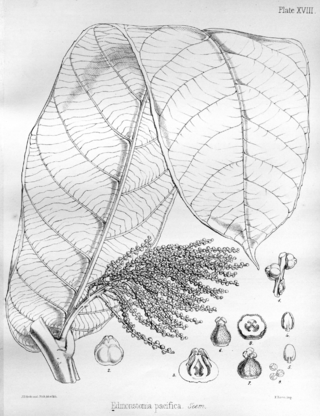
Tetrathylacium is a genus of flowering plants in the family Salicaceae. The genus spans across South America and parts of Central America, as far north as Costa Rica, and as far south as Bolivia.
Piparea is a genus of flowering plants belonging to the family Salicaceae.













